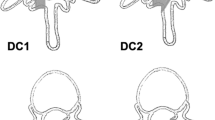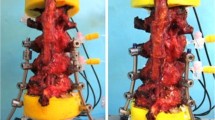Abstract
Undercutting decompression is a common surgical procedure for the therapy of lumbar spinal canal stenosis. Segmental instability, due to segmental degeneration or iatrogenic decompression is a typical problem that is clinically addressed by fusion, or more recently by semi-rigid stabilization devices. The objective of this experimental biomechanical study was to investigate the influence of spinal decompression alone, as well as in conjunction with two semi-rigid stabilizing implants (Wallis, Dynesys®) on the range of motion (ROM) of lumbar spine segments. A total of 21 fresh-frozen human lumbar spine motion segments were obtained. Range of motion and neutral zone (NZ) were measured in flexion-extension (FE), lateral bending (LAT) and axial rotation (ROT) for each motion segment under four conditions: (1) with all stabilizing structures intact (PHY), (2) after bilateral undercutting decompression (UDC), (3) after additional implantation of Wallis (UDC-W) and (4) after removal of Wallis and subsequent implantation of Dynesys® (UDC-D). Measurements were performed using a sensor-guided industrial robot in a pure-moment-loading mode. Range of motion was defined as the angle covered between loadings of −5 and +5 Nm during the last of three applied motion cycles. Untreated physiologic segments showed the following mean ROM: FE 6.6°, LAT 7.4°, ROT 3.9°. After decompression, a significant increase of ROM was observed: 26% FE, 6% LAT, 12% ROT. After additional implantation of a semi-rigid device, a decrease in ROM compared to the situation after decompression alone was observed with a reduction of 66 and 75% in FE, 6 and 70% in LAT, and 5 and 22% in ROT being observed for the Wallis and Dynesys®, respectively. When the flexion and extension contribution to ROM was separated, the Wallis implant restricted extension by 69% and flexion by 62%, the Dynesys® by 73 and 75%, respectively. Compared to the intact status, instrumentation following decompression led to a ROM reduction of 58 and 68% in FE, 1 and 68% in LAT, −6 and 13% in ROT, 61 and 65% in extension and 54 and 70% in flexion for Wallis and Dynesys®. The effect of the implants on NZ corresponded to that on ROM. In conclusion, implantation of the Wallis and Dynesys® devices following decompression leads to a restriction of ROM in all motion planes investigated. Flexion–extension is most affected by both implants. The Dynesys® implant leads to an additional strong restriction in lateral bending. Rotation is only mildly affected by both implants. Wallis and Dynesys® restrict not only isolated extension, but also flexion. These biomechanical results support the hypothesis that postoperatively, the semi-rigid implants provide a primary stabilizing function directly. Whether they can improve the clinical outcome must still be verified in prospective clinical investigations.




Similar content being viewed by others
References
Aalto TJ, Malmivaara A, Kovacs F, Herno A, Alen M, Salmi L, Kroger H, Andrade J, Jimenez R, Tapaninaho A, Turunen V, Savolainen S, Airaksinen O (2006) Preoperative predictors for postoperative clinical outcome in lumbar spinal stenosis: systematic review. Spine 31:E648–E663
Anderson PA, Tribus CB, Kitchel SH (2006) Treatment of neurogenic claudication by interspinous decompression: application of the X STOP device in patients with lumbar degenerative spondylolisthesis. J Neurosurg Spine 4:463–471
Benini A (1993) [Lumbar spinal stenosis. An overview 50 years following initial description]. Orthopade 22:257–266
Benini A (1997) [Stenosis of the lumbar spinal canal. Pathophysiology, clinical aspects and therapy]. Orthopade 26:503–514
Christie SD, Song JK, Fessler RG (2005) Dynamic interspinous process technology. Spine 30:S73–S78
Ciol MA, Deyo RA, Howell E, Kreif S (1996) An assessment of surgery for spinal stenosis: time trends, geographic variations, complications, and reoperations. J Am Geriatr Soc 44:285–290
Fuchs PD, Lindsey DP, Hsu KY, Zucherman JF, Yerby SA (2005) The use of an interspinous implant in conjunction with a graded facetectomy procedure. Spine 30:1266–1272 discussion 73–74
Fujiwara A, Lim TH, An HS, Tanaka N, Jeon CH, Andersson GB, Haughton VM (2000) The effect of disc degeneration and facet joint osteoarthritis on the segmental flexibility of the lumbar spine. Spine 25:3036–3044
Gibson JN, Waddell G (2005) Surgery for degenerative lumbar spondylosis: updated Cochrane review. Spine 30:2312–2320
Goel VK, Panjabi MM (1992) A new standard guide for the testing of spinal implant constructs, Part I: Guide for the multidirectional instability evaluation of the construct. ASTM (draft version) 6:1–9
Goel VK, Panjabi MM, Patwardhan AG, Dooris AP, Serhan H (2006) Test protocols for evaluation of spinal implants. J Bone Joint Surg Am 88(Suppl 2):103–109
Grob D, Benini A, Junge A, Mannion AF (2005) Clinical experience with the Dynesys semirigid fixation system for the lumbar spine: surgical and patient-oriented outcome in 50 cases after an average of 2 years. Spine 30:324–331
Gunzburg R, Szpalski M (2003) The conservative surgical treatment of lumbar spinal stenosis in the elderly. Eur Spine J 12(Suppl 2):S176–S180
Hurschler C, Pott L, Gossé F, Wirth CJ (2005) Sensor-guided robotic spine motion-segment biomechanical testing: Validation against the pure moment apparatus. Transactions of the 51st annual meeting of the Orthopaedic Research Society, vol. 30, Washington DC
Knaub MA, Won DS, McGuire R, Herkowitz HN (2005) Lumbar spinal stenosis: indications for arthrodesis and spinal instrumentation. Instr Course Lect 54:313–319
Lindsey DP, Swanson KE, Fuchs P, Hsu KY, Zucherman JF, Yerby SA (2003) The effects of an interspinous implant on the kinematics of the instrumented and adjacent levels in the lumbar spine. Spine 28:2192–2197
Mimura M, Panjabi MM, Oxland TR, Crisco JJ, Yamamoto I, Vasavada A (1994) Disc degeneration affects the multidirectional flexibility of the lumbar spine. Spine 19:1371–1380
Niosi CA, Zhu QA, Wilson DC, Keynan O, Wilson DR, Oxland TR (2006) Biomechanical characterization of the three-dimensional kinematic behaviour of the Dynesys dynamic stabilization system: an in vitro study. Eur Spine J 15:913–922
Panjabi MM, Oxland TR, Yamamoto I, Crisco JJ (1994) Mechanical behavior of the human lumbar and lumbosacral spine as shown by three-dimensional load-displacement curves. J Bone Joint Surg Am 76:413–424
Putzier M, Schneider SV, Funk J, Perka C (2004) [Application of a dynamic pedicle screw system (DYNESYS) for lumbar segmental degenerations: comparison of clinical and radiological results for different indications]. Z Orthop Ihre Grenzgeb 142:166–173
Rompe JD, Eysel P, Zollner J, Nafe B, Heine J (1999) Degenerative lumbar spinal stenosis. Long-term results after undercutting decompression compared with decompressive laminectomy alone or with instrumented fusion. Neurosurg Rev 22:102–106
Schmoelz W, Huber JF, Nydegger T, Claes L, Wilke HJ (2006) Influence of a dynamic stabilisation system on load bearing of a bridged disc: an in vitro study of intradiscal pressure. Eur Spine J 15:1276–1285
Schmoelz W, Huber JF, Nydegger T, Dipl I, Claes L, Wilke HJ (2003) Dynamic stabilization of the lumbar spine and its effects on adjacent segments: an in vitro experiment. J Spinal Disord Tech 16:418–423
Schnake KJ, Schaeren S, Jeanneret B (2006) Dynamic stabilization in addition to decompression for lumbar spinal stenosis with degenerative spondylolisthesis. Spine 31:442–449
Schulte TL, Bullmann V, Lerner T, Schneider M, Marquardt B, Liljenqvist U, Pietila TA, Hackenberg L (2006) Lumbar spinal stenosis. Orthopade 35:675–692
Schwarzenbach O, Berlemann U, Stoll TM, Dubois G (2005) Posterior dynamic stabilization systems: DYNESYS. Orthop Clin North Am 36:363–372
Senegas J (1991) La ligamentoplastie intervertebrale, alternative a l’arthrodese dans le traitement des instabilities degeneratives. Acta Orthop Belg 57(Suppl. 1):221–226
Senegas J (2002) Mechanical supplementation by non-rigid fixation in degenerative intervertebral lumbar segments: the Wallis system. Eur Spine J 11(Suppl 2):S164–S169
Senegas J, Etchevers JP, Baulny D, Grenier F (1988) Widening of the lumbar vertebral canal as an alternative to laminectomy in the treatment of lumbar stenosis. Fr J Orthop Surg 2:93–99
Senegas J, Vital JM, Pointillart V, Mangione P (2007) Long-term actuarial survivorship analysis of an interspinous stabilization system. Eur Spine J, Apr 11 (Epub ahead of print)
Stoll TM, Dubois G, Schwarzenbach O (2002) The dynamic neutralization system for the spine: a multi-center study of a novel non-fusion system. Eur Spine J 11(Suppl 2):S170–S178
Swanson KE, Lindsey DP, Hsu KY, Zucherman JF, Yerby SA (2003) The effects of an interspinous implant on intervertebral disc pressures. Spine 28:26–32
Tsai KJ, Murakami H, Lowery GL, Hutton WC (2006) A biomechanical evaluation of an interspinous device (Coflex) used to stabilize the lumbar spine. J Surg Orthop Adv 15:167–172
White AA, Panjabi MM (1990) Clinical biomechanics of the spine. 2nd ed. Lippincott, Philadelphia
Wilke HJ, Drumm J, Häussler K, Claes L (2006) Segmental stability and intradiscal pressure achieved with different interspinous implants. Eur Spine J 15:1561–1632
Wilke HJ, Schmidt H, Werner K, Schmolz W, Drumm J (2006) Biomechanical evaluation of a new total posterior-element replacement system. Spine 31:2790–2796 discussion 7
Wilke HJ, Wenger K, Claes L (1998) Testing criteria for spinal implants: recommendations for the standardization of in vitro stability testing of spinal implants. Eur Spine J 7:148–154
Wiseman CM, Lindsey DP, Fredrick AD, Yerby SA (2005) The effect of an interspinous process implant on facet loading during extension. Spine 30:903–907
Yamamoto I, Panjabi MM, Crisco T, Oxland T (1989) Three-dimensional movements of the whole lumbar spine and lumbosacral joint. Spine 14:1256–1260
Zucherman JF, Hsu KY, Hartjen CA, Mehalic TF, Implicito DA, Martin MJ, Johnson DR 2nd, Skidmore GA, Vessa PP, Dwyer JW, Puccio S, Cauthen JC, Ozuna RM (2004) A prospective randomized multi-center study for the treatment of lumbar spinal stenosis with the X STOP interspinous implant: 1-year results. Eur Spine J 13:22–31
Zucherman JF, Hsu KY, Hartjen CA, Mehalic TF, Implicito DA, Martin MJ, Johnson DR 2nd, Skidmore GA, Vessa PP, Dwyer JW, Puccio ST, Cauthen JC, Ozuna RM (2005) A multicenter, prospective, randomized trial evaluating the X STOP interspinous process decompression system for the treatment of neurogenic intermittent claudication: two-year follow-up results. Spine 30:1351–1358
Author information
Authors and Affiliations
Corresponding author
Rights and permissions
About this article
Cite this article
Schulte, T.L., Hurschler, C., Haversath, M. et al. The effect of dynamic, semi-rigid implants on the range of motion of lumbar motion segments after decompression. Eur Spine J 17, 1057–1065 (2008). https://doi.org/10.1007/s00586-008-0667-0
Received:
Revised:
Accepted:
Published:
Issue Date:
DOI: https://doi.org/10.1007/s00586-008-0667-0




